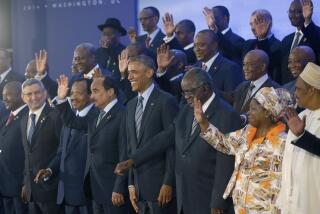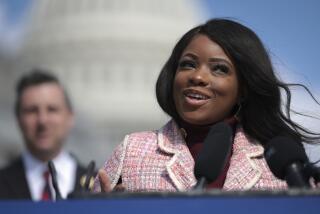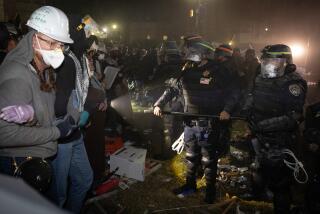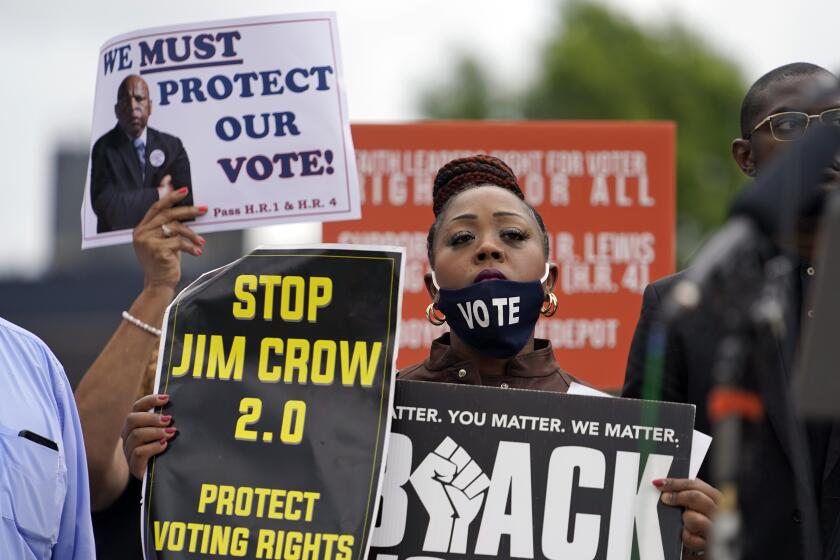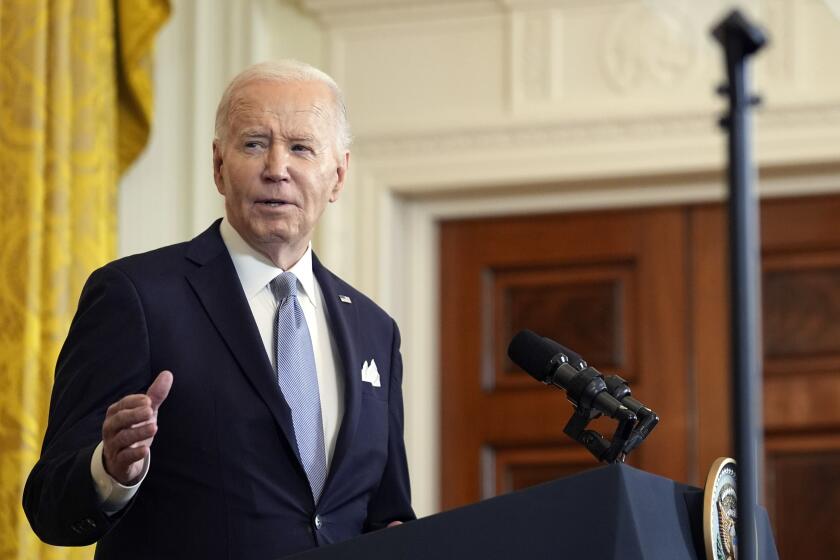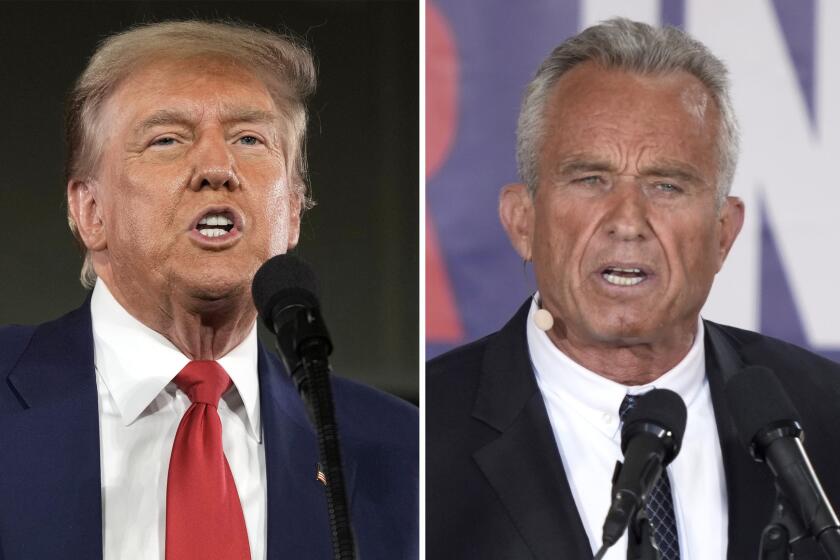Bush Sets 10-Year Plan for Clean Air : Favors Alternative Fuels, Tough Rules on Smog, Acid Rain, Toxic Emissions
President Bush, moving to break a decade-long political stalemate on clean air, Monday proposed a far-reaching plan to curb smog, acid rain and toxic emissions.
Officials estimated that it would cost industry and consumers from $14 billion to $19 billion a year when fully implemented at the turn of the century.
“The wounded winds of North, South, East and West can be purified and cleansed,” Bush declared in presenting a blueprint that in key parts resembles Democratic proposals in Congress.
The package, described by Environmental Protection Agency chief William K. Reilly as “very ambitious and expensive,” calls for the first major rewrite in a dozen years of the Clean Air Act of 1970 and envisions these achievements by 2000:
--Bringing all but three of the 81 smoggiest cities up to air health standards. This would be done largely by slashing motor vehicle tailpipe emissions and by requiring 1 million cars to run on methanol and other clean-burning fuels. Los Angeles, Houston and New York would have an extra 10 years to meet the cleanup deadline.
--Halving emissions of sulfur dioxide, principally by requiring coal-burning electric power plants in the Midwest to adopt new technologies. This would substantially reduce acid-rain damage to lakes, forests and buildings mostly in the Northeast and Canada.
--Cutting up to 90% of the toxic compounds spewed into the air by factories and industrial plants. Medical experts say this could eliminate an estimated three-fourths of the annual cancer deaths believed to be caused by such toxics.
The proposals embody an innovative “marketplace” element that would give utilities, auto makers and the oil industry considerable flexibility in meeting cleanup requirements. The approach represents a marked departure from regulations that require each firm in an industry to meet the same standards.
Under the new policy, individual firms could sell or trade their cleanup obligations among themselves as long as their industry met overall goals. For example, a company that needed to pollute more than its share could buy that right from a company that would agree to pollute less.
Advocates of the approach said it would make pollution cleanup more cost-effective than traditional “command and control” methods.
Months of Debate
The unveiling of the Bush plan comes after months of internal debate within the Administration, which had made the clean air proposal a key element in its package of domestic policy initiatives for the nation.
The proposal appears to mark a middle ground between the stringent course sought by EPA chief Reilly and the one backed by Budget Director Richard G. Darman and others, who had warned of the high cost of such efforts.
Bush, who has pledged to be an “environmental President,” outlined his proposals to congressional leaders, governors, business executives and conservationists at a White House ceremony, then flew to Yellowstone National Park for an appearance intended in part to dramatize the benefits of pristine air.
“We’ve seen enough of this stalemate,” he said at the White House session, referring to the inability of Congress and the preceding Ronald Reagan Administration to work out a plan. “It’s time to clear the air.”
Bush’s effort to forge a compromise between the issue’s competing forces won a largely favorable reaction from a wide variety of sources. But it drew some negative response from California, where state clean air regulations generally match or exceed the President’s proposals.
Still, environmentalists generally praised the plan as a positive sign, voicing particular support for the acid rain proposal but indicating that they would push for further steps to curb urban smog and toxic pollution.
Industrial leaders, on the other hand, expressed support for the Administration’s adoption of the “market-based” approach to pollution reduction.
And nearly all sides welcomed the Bush proposal as a step that would break the legislative logjam that had stalled previous proposals.
‘Significant Departure’
“This is a significant departure from the negative environmental policy of the Reagan Administration, which opposed every clean air bill considered by Congress for the past eight years,” said Senate Majority Leader George J. Mitchell (D-Me.).
Sen. John H. Chafee (R-R.I.), a leader on environmental issues, said that the Bush proposals “make tremendous steps in every aspect.”
A number of alternative clean air proposals are already before Congress or are expected to be introduced shortly. But the Bush proposal is expected to become the principal vehicle because it appears to have the broadest base of support.
Both the President and key legislators have said they hope to pass legislation this year.
Obstacles Remain
However, in an indication that formidable obstacles remain, influential Sen. Robert C. Byrd (D-W.Va.) charged that the acid rain proposal was “not equitable” and would cause further loss of coal-mining jobs in his already-depressed home state.
And Rep. Henry A. Waxman (D-Los Angeles), the principal architect of the most far-reaching proposals now before Congress, charged that the Administration had “fallen short” of requiring the auto industry to take adequate steps to reduce urban smog.
The President’s program for combating smog calls for a mix of federal measures and state initiatives that would cost an estimated $8 billion to $13 billion a year by the year 2000.
To cut smog’s key ozone ingredient, which is formed when volatile organic compounds are mixed with nitrogen oxides in the presence of sunlight, the Bush proposals include:
--Tightening the tailpipe standard for hydrocarbons by almost 40%, bringing it to the level soon to be required on all California vehicles. (The new standards for carbon monoxide and nitrogen oxide emissions, however, would remain far more lenient than California allows.)
--Requiring a significant proportion of new automobiles sold in the nation’s nine smoggiest cities to be capable of burning methanol and other clean fuels, beginning in 1995.
In that year, auto makers would be required to produce 500,000 such vehicles, while oil companies would have to make appropriate fuel available at a cost competitive with gasoline. The production requirement would increase to 1 million by 1997.
The cities affected would include Los Angeles, San Diego, Houston, New York, Milwaukee, Baltimore, Philadelphia, Chicago and metropolitan areas of Connecticut.
Could ‘Opt Out’
If any of the affected cities is able to reduce emissions some other way, it would be able to “opt out” of the program and use proportionately fewer vehicles with alternative fuels.
Automobile manufacturers would also be able to strike deals with each other on the number of alternative-fuel cars each would produce to meet the overall targets, according to the outlines of the plan unveiled Monday. But details of that proposal were murky.
Reilly indicated that the oil industry would receive subsidies as an incentive to step up alternative-fuel production. But the American Petroleum Institute, representing the industry, blasted the proposal as “costly and inflexible.”
Together, emission controls and alternative fuels would reduce the proportion of ozone pollution caused by automobiles from 40% to 10%, according to Administration estimates.
The acid rain proposal to cut 10 million tons of sulfur dioxide and 2 million tons of nitrogen oxides would cost an estimated $4 billion in cleanup equipment and higher electric utility rates, the Administration said.
The proposal, praised by environmentalists and the Canadian government, marks a major step toward resolving contentious disputes between the Canadians and Northeasterners beleaguered by acid rain and the Midwesterners whose coal-burning power plants cause the phenomenon.
In its initial five-year phase, the burden for cleanup would be placed on the nation’s 107 most-polluting power plants in 18 states in the Midwest, South and East, which would be required to install “scrubbers” or other technologies to reduce sulfur dioxide emissions.
Bush’s chief of staff, John H. Sununu, told reporters traveling on Air Force One that utility customers in affected areas would face estimated rate hikes of from 5% to 10%.
To promote flexibility, utilities would be able to trade required reductions in pollutants. The acid rain plan is similar to that pressed in the Senate by Majority Leader Mitchell. But it will be controversial because of the cost to electric utilities, rate payers and regions that produce high-sulfur bituminous coal.
Bush’s plan to dramatically accelerate cleanup of toxic air pollutants would cost an estimated $2 billion a year.
The proposal is aimed mainly at motor vehicles and stationary sources such as steel mills and rubber, pulp, paper and solvent users.
The EPA estimates that 2.7 billion pounds of toxic chemicals are emitted each year, contributing to approximately 1,500 to 3,000 fatal cancers annually. Although the agency has been required since 1974 to regulate hundreds of such emissions, it has so far regulated only seven.
Under the plan, the EPA would impose controls on the 10 types of industries that produce the most severe toxic emissions within two years, 25% of the overall total of toxic-producing industries within four years, 50% within seven years and “all necessary additional categories” within 10 years.
RELATED STORIES
Car firms resist change. Page 16.
Huge costs for cleanup. Page 17.
Growing health risk. Page 17.
Methanol drawbacks. Page 17.
Criticism of toxics plan. Page 19.
More to Read
Get the L.A. Times Politics newsletter
Deeply reported insights into legislation, politics and policy from Sacramento, Washington and beyond. In your inbox three times per week.
You may occasionally receive promotional content from the Los Angeles Times.
